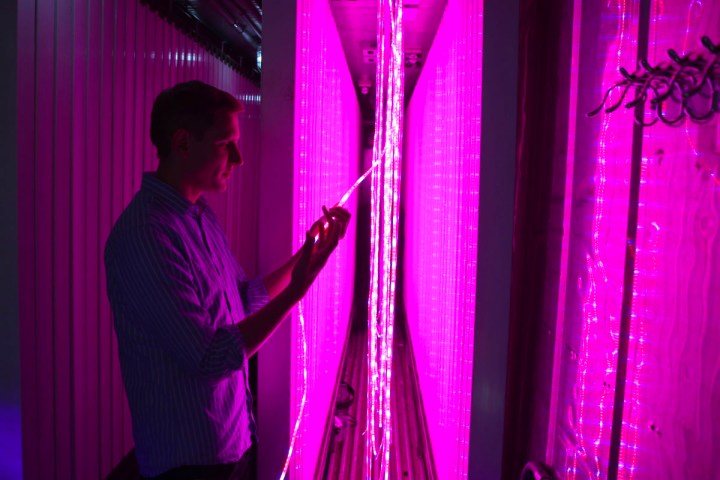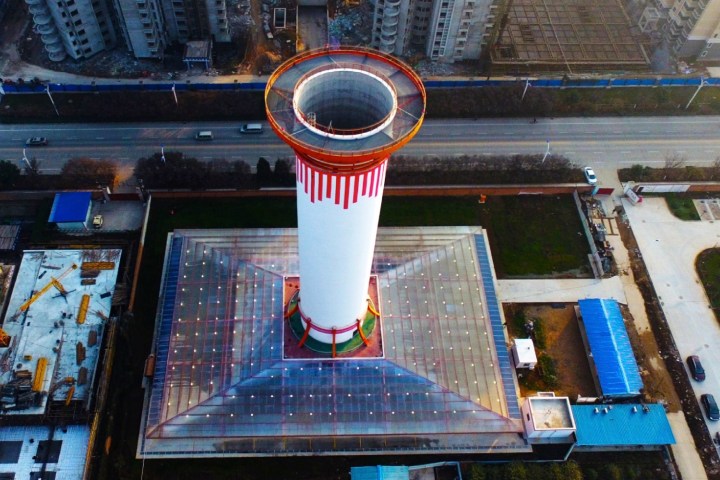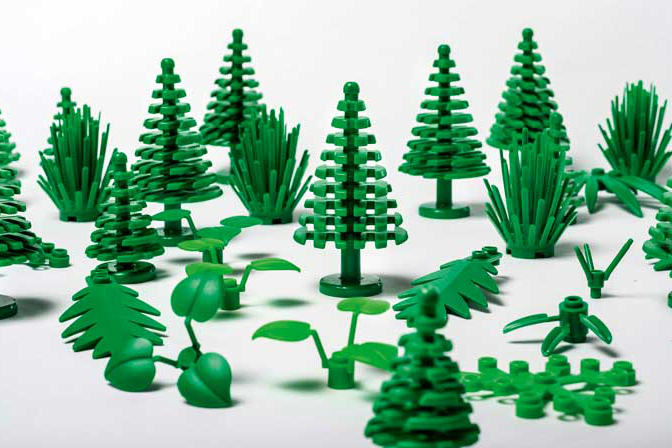
We love when technology gives us new gadgets or entertaining features, but it’s even better when scientists get together and use technology for more noble pursuits… like saving the planet. That’s right: From biodegradable bullets to robot bees, today’s eco-friendly creations are literally changing the world for the better.
If you need a more optimistic look at the future, check out these promising pieces of modern tech, each of which is greening up everyday activities and fixing a problem we once thought unsolvable.
A sea net designed to clean up the GPGP

For those who don’t know, the Great Pacific Garbage Patch is a giant collection of trash — one made primarily of plastics and other materials that don’t disintegrate in water — that’s currently adrift in the middle of the Pacific. If you want to get technical, it’s called a marine trash vortice, and it’s larger than many countries.
Ocean Cleanup is an organization dedicated to finding innovative waves of getting rid of the GPGP before it gets even worse. Do you remember those floating, connected markers at the public pool? Ocean Cleanup has devised a heavy-duty version of those lines, except each float is actually a polyurethane trash collector that filters out and captures pieces of the GPGP.
The goal is to attach these lines to sea vessels and have them pass in and out of the garbage patch to help clean it up. Simulations show that this could reduce the GPGP’s size by almost 50 percent in five years, thus reducing its impact on aquatic life.
A graphene filter that makes salt water drinkable

The severe water shortages facing many parts of the world could be solved if there was an easy way to filter salt out of seawater and make it drinkable. Desalination plants do exist, but they are complex, expensive to build, and can’t be used everywhere. Now a team of scientists in the U.K. thinks it has a solution that could transform the world’s water needs.
Enter a carefully designed graphene filter made from a single layer of carbon atoms in a hexagonal lattice. This type of graphene layer can do all kinds of cool stuff, but scientists are currently using it to develop a graphene oxide sieve that could filter out salts — and can do it far more effectively than current desalinization plants, at a fraction of the cost.
The U.S. Army’s biodegradable bullets

In addition to all the other problems with war, bullets are actually really bad for the environment; they can leach toxic metals into the soil that can kill plants, harm animals, and build up in nearby communities, eventually causing medical problems.
Enter the U.S. Army’s plan to create biodegradable bullets. Basically, they want to use bullets made out of composite materials that can act as much like real bullets as possible, and can be fired using current weaponry. This will allow soldiers posted around the world to conduct typical training regimens without worrying about the impact of the bullets on the surrounding environment.
Even better, the final bullets chosen for the project may include hibernating seeds, which are designed to take root in the soil months later and sprout into environmentally-beneficial plants. How crazy would that be?
A chimney that gets rid of pollution

China has been hard at work trying to reduce its sizable pollution problem and make cities safer to live in for years now. This involves traditional solutions such as solar and wind power, along with more innovative approaches — like this 200-foot chimney in Xi’an.
The chimney’s genius design uses solar heating to warm pollution particles drawn in at the chimney’s base, forcing them into a network of filters housed within the shaft. The particles are then trapped as the warm air continues to rise, creating a healthy cycle that pushes clean air into the city. The chimney can currently handle particles less than 2.5 micrometers in diameter, which is particularly impressive for this kind of project. If the creation is deemed a success, these towers could appear in cities around China.
A plane powered via fuel cells

Here’s a crash course (no pun intended) on the fuel cell: It creates an electrical current by utilizing a chemical reaction between hydrogen and oxygen. Stack enough of these fuel cells together, and they become powerful enough to operate larger machines, including vehicles. The only byproduct of a fuel cell is, famously, water.
The problem is that fuel cells are difficult and expensive, at least when you’re dealing with larger vehicles. Plus, you need a handy source of hydrogen gas to keep the vehicle powered. That’s why you don’t see too many fuel cell cars on the road, though, there are a handful of car manufacturers that offer fuel cell variants.
All this makes this German plane even more impressive, because it manages to carry several passengers while running on nothing by fuel cells. In many ways, this four-seater is more suited for fuel cells than cars are, especially when it comes to refueling. The creators are hopeful that these planes could be used as eco-friendly taxis between nearby cities.
The “Leafy Green Machines” NASA wants to put in space

Freight Farms, by themselves, are already impressive eco-friendly constructs; these little grow rooms are manufactured using recycled freight crates with advanced hydroponics that allow them to grow racks of farm-fresh produce even in the middle of the city. Companies like Freight Farms are currently mass producing these “Leafy Green Machines,” providing cities that receive little daylight or currently face produce shortages with a better method for growing crops.
That’s already cool, but it gets cooler! NASA has given Freight Farms and Clemson University a grant to study how the Leafy Green Machines could be used in space travel. Basically, NASA wants to take these freight gardens to the next level and see if they can become entirely independent. If they can run on renewable energy and produce enough food to support humans, they may be ideal for growing in-flight produce.
A streetlight powered via used car batteries

Electric cars are becoming more and more common, but there are some issues when it comes time to replace their batteries, which often need to be swapped out while they’re still operational. Note: Electric cars require their batteries to be in peak condition in order to operate correctly.
Rather than let these batteries go to waste, Nissan decided to do something with them, and created The Reborn Light project. The project’s aim is to take used batteries from electric cars and attach them to LED-equipped streetlights, allowing them to run for years with little maintenance. Early reports say they can provide the same sort of visibility as traditional streetlights, though, they capitalize on a planet-saving approach we can all get behind.
The best solar roof on the market

Quick! What’s the big problem people have with installing solar roofs? For the average homeowner, the short answer is either “installation” or “appearance.” Most people simply don’t want a cumbersome solar panel on their roof, especially when it comes with additional structural concerns.
Thankfully, Tesla has developed a more discrete type of solar roof. The intuitive design utilizes tiles that look like shiny, ultra-modern versions of the same clay or stone tiles luxury homes have used for decades. Not only do these solar panels protect your roof from rain, pests, and so on, they are also great at producing energy. In fact, they are more efficient than the average solar panel that’s often marketed toward consumers, and they’re cheaper than a normal roof.
Although Tesla’s solar panels are only available under limited conditions in a few markets, there are plans to expand into new territories in the near future, and to offer a greater variety of tile appearances.
The machine that reduces carbon emissions (permanently)

The biggest problem with greenhouse gases is that once they’re out and about, it’s really hard to do anything about them. Carbon capture and storage is, at least currently, notoriously difficult and often temporary. Luckily, a startup called Climeworks and an Icelandic project called CarbFix have teamed up to change all of that.
Together, these researchers have developed a machine that has been attached to the Hellisheidi Power Station, which is being hailed as the greenest power plant in the world. In addition to using geothermal energy, the plant now takes in carbon dioxide from the atmosphere and injects it into the basalt rocks beneath the plant. CO2 and basalt combine to form permanent carbonate rocks, which will house the carbon permanently. It’s still something of a prototype, though, so here’s hoping larger versions can be developed soon!
A bacteria strain that generates energy from sunlight and CO2

Yes, the field of “cyborg bacteria” is now a real thing. The term essentially refers to bacteria that have been engineered to coat themselves with nanocrystals. These nanocrystals are grown from cadmium and cysteine that scientists feed to the new bacteria, and they function as little solar cells that turn sunlight into energy.
The bacteria, in turn, use this solar energy to turn carbon dioxide and water into acetic acid, which they can use as a food source. Not only is this process more efficient than the chlorophyll-based method used by plants, it also shows great potential as a new C02-removal system, one that could help scrub our atmosphere and oceans. Scientists are also looking into ways to use the bacteria as a major energy producer, which, down the line, could lead to some exciting advancements in the solar field.
Robotic bees that are designed to pollinate

If you’re up to speed on your ecology news, then you’re probably already aware that bees are dying off at an unprecedented rate. Whether the cause is a changing climate, new diseases, pesticides, or a combination thereof, it’s bad news for anyone who depends on bees for pollination.
The good news is that this has led to some serious innovation, including the development of robotic bees, aka B-Droids. These robots aren’t just lab drawings, either. Prototypes were developed and launched in 2014, and more advanced versions of the B-Droid have continued to appear in the years since. The latest version functions like a mini quadcopter, and has successfully pollinated both garlic and strawberries via a set of cameras and algorithms that coordinate flight paths between flowers. Thanks for saving the planet, robots!
Leather that doesn’t rely on animals

Human fabrics are rarely eco-friendly — leather, in particular. Unlike cotton or wool, animal skin isn’t exactly renewable, which means it takes a serious ecological toll to produce. And anyone who has tried cheap pleather products knows that the synthetic version isn’t exactly satisfying, especially in the long term.
Thankfully, Modern Meadow’s has developed a new solution. After years of research and millions of dollars in investment, the company has officially created a biofabrication technique that results in animal-free leather. How does this miracle work? It uses yeast cultures that are engineered to create collagen, the biological material that skin is formed from. Scientists then take that collagen and process it into leather, basically in the same way that real leather is created.
Not only is the new leather poised to revolutionize the clothing industry, it also apparently feels and acts just like the real thing. Scientists can even switch up the processing method to create different colors, new textures, or entirely new fabric types that rely on cotton and other materials.
Legos made from biodegradable materials

At first, “bioplastic” sounds like an oxymoron: How can plastic be biological or eco-friendly when it’s famously not? That said, Lego has found a way. The iconic company — you know, the one behind those colorful blocks you always step on in your living room — has just introduced a new line made entirely from biodegradable materials.
The secret is a new process that turns sugar cane into a plant-based plastic, one that acts like traditional plastic with a few advantages. The new Legos are eco-friendly and just as durable as the older models, for instance, and they’re softer to the touch.



